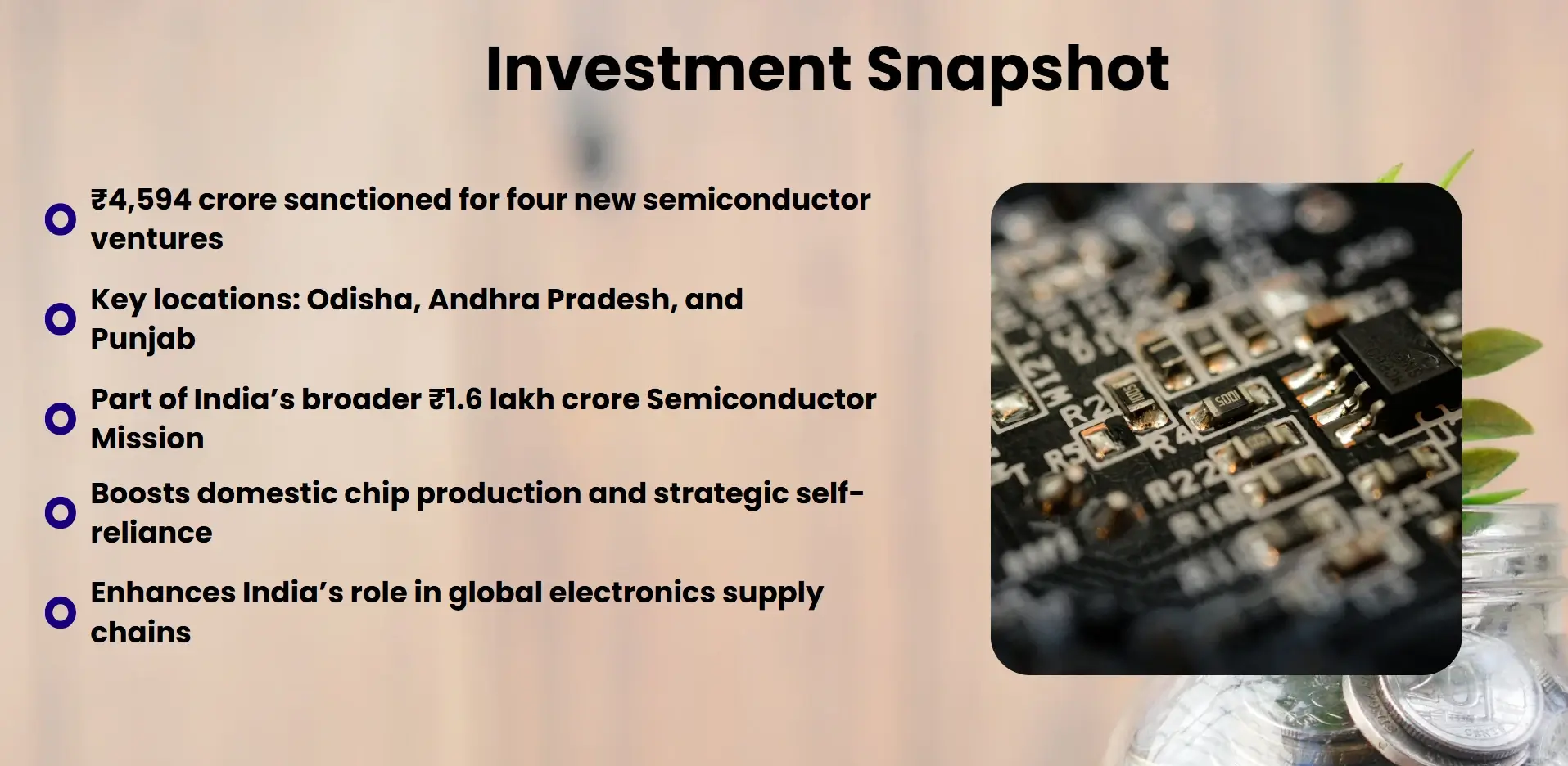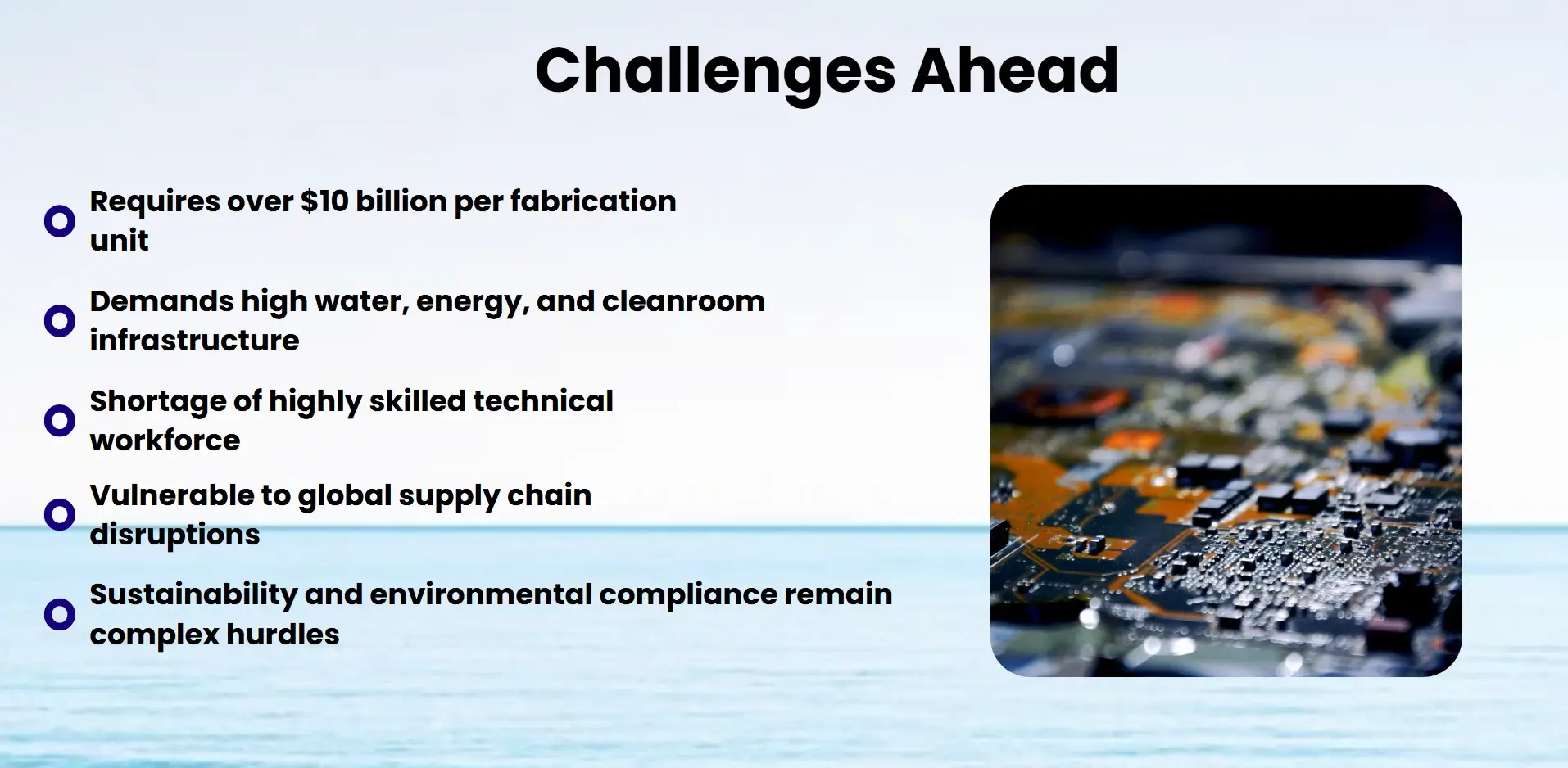On August 12, 2025India's Union Cabinet approved four additional semiconductor manufacturing projects under the India Semiconductor Mission (ISM). The newly approved plants will be located in three states, namely, Odisha, Punjab, and Andhra Pradesh. India has endorsed four new semiconductor production plants with a total investment amounting to 4,594 crore to enhance its ambition of becoming a world chip-producinghub with strategic capacity enlargements.

India is driving its plans to become a global semiconductorgiant and the government has received four new initiatives after the Union Cabinet approved 4 projects worth 4,594 crore. This is a bold investment that could be a milestone in the ambitions of the country to reinforce its electronic manufacturing submarine and stop relying on imported chips. It follows six other semiconductor projects that have been granted prior approval and together have an annual production capacity of 24 billion chips, which further cements the weight behind the Indian authorities’ determination of setting up a robust and independentsemiconductor industry.These projects represent the larger Semicon India Programme, which was initiated as a flagship programme to foster innovation, and attract global investments in semiconductors and build a strong local supply chain in the country. The active policy and investment strategy are economically and geopolitically relevant in India, as the semiconductor industry of semiconductors is the leading technology, from smartphones and electric transportation to conscious design and artificial intelligence. As the world and supply chain face more demand and get disrupted with weaknesses being highlighted, localizing chip production in the country becomes timely and a strategic move.The article discusses the specifics of the now passed projects as well as the advancements of the previously passed ones, as well as the extent of the discussions in the digital future, economic development, and international competitiveness of India within the sphere of semiconductors.
Government Approves ₹4,594 Crore for Four New Semiconductor Projects in Odisha, Punjab, and Andhra Pradesh
The Union Cabinet recently gave a fillip to India's semiconductor ambitions by approving four new projects worth 4,594 crores to increase the national chip-making footprint in Odisha and Punjab, and Andhra Pradesh.India’s semiconductor market, valued at $22 billion in 2019, is on an explosive growth trajectory, with expectations to surge to $64 billion by 2026, and further to $110 billion by 2030.

Silicon carbide Fab in Odisha
- Company: SiCSemPvt. Ltd.
- Location: Bhubaneswar- Info Valley
- It is planned to be the first commercial compound semiconductor fabrication in India concentrating on silicon carbide (SiC) devices. Having an annual production of 60,000 wafers and 96 million packaged units, the plant is aimed at such strategic industries as defense, electric vehicles, railways, solar inverters and data-centers. Vaporizing at temperature 2,400C of SiC powder and accreting it on the crystals are the steps that make up the precise process of manufacture of the wafers.
Packaging unit of 3D Glass
- Company: 3D Glass Solutions Inc.
- Location: Info Valley, Bhubaneswar
- The given project will bring the latest 3D heterogeneous integration (3DHI) and embedded glass substrate technologies to India. 13200 3DHI modules, 50 million assembled units, and 69,600 panel substrates are expected to be produced annually by the facility. Use cases include defense, artificial intelligence, photonics, automobiles and high performance computing.
Semiconductor Punjab Growth Discrete
- Company: Continental Device India Pvt. Ltd.(CDIL)
- Location: Mohali
- CDIL will also use this facility to produce MOSFETs, IGBTs, and Schottky diodes, which are high-power discrete devices, as an expansion of the existing facility. The 158.38 millionunits that the plant is expected to manufacture every year will help advance the EV infrastructure, renewable energy, and industrial electronics.
ASIP technologies (AP)
- Company: Advanced System in Package Technologies Pvt. Ltd. (ASIP), in partnership with APACT Co., Ltd., South Korea
- Place: Andhra Pradesh
- The plant will produce 96 million semiconductor packages yearly on mobile phones, set-top boxes and automobile electronics. It is a landmark in the advanced capabilities of India regarding packaging.
The Semiconductor strategy by India
India is strategically developing its semiconductor industry through the India Semiconductor Mission (ISM), a comprehensive initiative focused on building a robust domestic ecosystem and reducing import reliance. This involves significant financial investments, policy support, and global collaborations. The Indian semiconductor roadmap is an ambitious plan to create India as a chip designing, manufacturing, and innovation center of the world-based on the strategic investments and policy changes.
Policy Framework
The India Semiconductor Mission (ISM) launched in the year 2021is central to India chip strategy. It will develop a complete ecosystem in semiconductors. The mission is assisting fabrication plants, ATMP (Assembly, Testing, Marking and Packaging) facilities and design-correlated initiatives. Through the recent approvals by the Cabinet, ISM has ten projects in six states all with a total investment of 1.6 lakh crore.
Corporate Strategy and Positioning
This is not only a strategy of self-sufficiency at home, but a strategy to be relevant in the world. India is also on course to becoming a feasible alternative to the conventional chip hub Taiwan, South Korea and the US, through the development of indigenous capabilities in compound semiconductors, advanced packaging, and discrete devices. This emphasis on silicon carbide fabs and 3D heterogeneous integration technologies to support newer areas like EVs, AI and defense electronics is far-sighted.
Ecosystem and Innovation
The government has invested in talent development and design infrastructure in order to facilitate this industrial leap. These include over 278 academic organizations, 72 start-ups supported, and building a pipeline of skilled engineers and innovators in the field of chip design, research and development. There are more than 60,000 students undergoing training in semiconductor related work these days thus bringing long-term sustainability to the field.
Vision for Aatmanirbhar Bharat
Aatmanirbhar Bharat and Digital India also incorporate the semiconductor industry's strategy. Due to the localization of chip production combined with fostering innovation, the country plans to achieve its digital sovereignty to spur economic growth in the different industries.

Previously Approved Projects
With a capacity of 24 billion chips, the six foundational projects that India embarked on in 2011 to launch the India Semiconductor Mission (ISM) marked the beginning of the country's semiconductor industry and cleared the path for a robust domestic ecosystem.
Building Manufacturing Capacity
The six projects already approved comprise of a combination of fabrication units, ATMP (Assembly, Testing, Marking and Packaging) facilities, design design-linked projects. Such initiatives have been distributed throughout states such as Gujarat, Karnataka, and Tamil Nadu, and have seen international collaboration in terms of investments by Intel as well as partnership with overseas companies. Their cumulative production capacity of 24 billion chips per year is a huge step towards fulfilling the Indian demand in numerous multi-fold ways like telecom, automotive, consumer electronics and defense.
Innovating and Designing
Other than manufacturing, such projects have activated the chip design ecosystem in India. It has assisted more than 278 academic organizations and 72 start-ups by availing the design tools, training facilities and R&D infrastructure. This has resulted in the formation of home-grown design capabilities, be it in AI and Photonics, automobile electronics and wireless communication.
Strategic and Economic Impact
The success of these first projects has now placed India in the position as a viable player in semiconductor supply chain globally. They have already created thousands of skilled employment, in addition to drawing venture capital and they have established premises around cutting edge technologies such as silicon carbide and 3D heterogeneousintegration. These developments have reinforced India in digital sovereignty and economic independence as part of the Aatmanirbhar Bharat program.
Importance for India
India wants to turn into a semiconductor manufacturing nation, but that is not merely an industrial modernization project, it is also a strategic decision to become technologicallysovereign, economically independent, and globally relevant in an increasingly digitally-dominated world.
National Security and Technological sovereignty
Semiconductors are at the part of national security. As an example, the recently granted silicon carbide fab in Odisha will manufacture silicon chips in missiles, satellites, telecom towers and railway engines. The self-reliance in semiconductor is the ladder to be a developed country. Localization of the chip production in India decreases its dependence on foreign global supply chains, cutting across tensions and culminating in the control of Taiwan and the aggressiveness of China in the industry.
Economic Growth and Diversification of Industries
The four new initiatives will result in more than 2,000 high-quality jobs and drive secondary employment within electronics manufacturing supply chain. The industry is also set to become a significant GDP generator on the back of cumulatively invested 1.60 lakh crore in the industry now under India Semiconductor Mission. Regional growth and ancillary industries are also set to benefit as new facilities in Punjab, Andhra Pradesh and Odisha are built. These facilities will host clean energy industries and offering up automotive electronics among others.
International partnerships
The global semiconductor companies are Intel, Lockheed Martin and APACT Co. Ltd that are being attracted to India semiconductor strategy. Through these partnerships, India is able to receive technologies like 3D heterogenous and embedded glass substrate that have improved the competitiveness of the country. The projects further coincide with India ambitions to enhance growth in other areas of diplomatic and trade which will allow the country to be an assured workforce supplier in the worldwide technology chain.
Challenges and Road Ahead

The semiconductor journey in India is ambitious but the road to self-reliance is filled with technological, infrastructural and geopolitical challenges that require both strategic foresight and long-term investments.
Technology Complexity and Capital Intensity
Producing semiconductors is one of the most complex manufacturing processes with very clean conditions, high engineering precision and accuracy in nanometres. The factors that present challenges are a lack of legacy skills and reliance on imported hardware and intellectual property in India. The cost of building one fab can be in excess of 10 billion dollars and any involvement in the private sector cannot be risk-taking unless a solid government support is put in place.
Infrastructure gaps and resource squeeze
The process of Semiconductor manufacture is energy and water-intensive. The prevalent water shortage and power grid problems in India might be a setback to an enormous scale. In addition, it is still required to upgrade the logistics infrastructure, particularly in tier-2 and tier-3 cities where new fabs are set to be located, in order to accommodate high-tech manufacturing ecosystems.
Skill Development
The field calls for strongly narrowed-down engineers in VLSI design, materials science and cleanroom operations. Though India has a well-skilled IT workforce, the semiconductor sector needs to be skilled in specific areas and has to collaborate with academia and industry. The effort of supporting 278 academic institutions by the government is a good beginning but expanding to the required demand in the future should prove a challenge.
Risk in Supply Chains
India continues to rely on international suppliers of key raw materials and equipment most of which are concentrated into the hands of few countries. Developments may be stymied by trading tensions, export and intellectual property constraints, particularly U.S., Chinese and Taiwanese. It will be important to diversify supply chain and strategic partnership.
Road Ahead
To meet the challenge, India has to pursue a two-tailed policy: reinforcing home bred R&D, bringing in big international players, coordination of inter-state activities, in addition to investing in sustainable infrastructure. The two pillars are the Production Linked Incentive (PLI) scheme and India Semiconductor Mission, whose success in the long-run depends on ecosystem maturity and sustenance of policies.
Conclusion
The semiconductor mission of India is a breakthrough towards technological independence, industrial buoyancy, and strategic international status. The introduction of new fabs and OSAT plants is an indication of a high incentive yet the success shall lie in the way these challenges are solved, including infrastructure and talent shortages, as well as geopolitical reliance. As India continues to focus on policy support and targeted skilling, an ecosystem developed by global partnerships in the semiconductor industry can form the backbone of breakthroughs in AI, defence, mobility and clean energy.It is not simply an industrial journey, it is invested in the future of India digitally, it'sthe desire to be a leader in the Fourth Industrial Revolution. With the country aiming to put its technological aspiration into strategic perspective, the path it has to travel with should thus be covered with resilience, teamwork, and foresight. The semiconductor industry, long considered an esoteric outpost, is at the heart of Indian Aatmanirbhar Bharat storiesand its bright future as a reliable international technology partner.